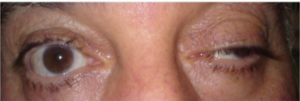Dr. Frankel’s Case of the Week:When a headache is not just a headache
A 61-year-old male presented to our clinic with complaints of horizontal diplopia for 3 days. He was seen at a nearby ER a few days prior to the onset of his diplopia, with complaints of a severe headache. He was released with unremarkable MRI, CT and carotid ultrasound reports. While in our office, during history taking, he underwent syncope and was placed in a reclined position until he became stable. At that time, he was noted to have drooping of the right upper lid and the eye was turned out and unable to adduct. Shortly thereafter, the patient began to vomit and became extremely dizzy.
We immediately called for ambulatory pick-up and called the ER to report that we were sending in a patient with suspect partial third-nerve palsy and needed immediate MRA of the neck and head. The cerebral angiography reported high-grade stenosis of the distal end of the basilar artery.

The basilar party is a main artery in the brain that supplies the brainstem, cerebellum and occipital lobes with oxygen-rich blood. The brainstem is the portion of the brain responsible for a murid of our daily functions (i.e. breathing, eye movements, taste, hearing, etc). When this main artery is unable to perfuse an appropriate amount of blood to our brainstem, the distal tissue becomes atrophic and this is known as a stroke. Commonly, a stroke of the basilar artery can lead to Locked-in syndrome (when a patient is aware but is unable to communicate).
Patients with stenosis of the basilar artery have a significant risk of disabling stroke. Patients with symptomatic stenosis of the basilar artery are usually initially treated medically with antiplatelet agents and/or systemic anticoagulation. Despite this, the risk of stroke remains high. The Warfarin-Aspirin Symptomatic Intracranial Disease (WASID) study reported the annual risk of stroke in the basilar artery territory as 20% for patients with symptomatic basilar artery stenosis treated with aspirin and 12% for those treated with warfarin. For the subset of patients for whom medical therapy fails, the therapeutic options are limited. Surgical bypass-grafting for basilar artery stenosis is technically demanding and the results are often disappointing. Successful balloon angioplasty of the basilar artery was first reported by Sundt et al in 1980; however, intraprocedural vessel rupture, elastic recoil, and flow-limiting intimal dissection remain potential problems leading to its minimal usage. Flexible stents have enabled reliable and atraumatic percutaneous access of the intracranial vasculature and are becoming increasingly more common as a treatment modality.
To have your eyes dilated and to check for any major ocular diseases, make an appointment with Dr. Frankel. Give our office a call or simply schedule an appointment via ZocDoc.
